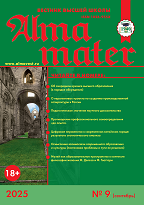UDC 378+613.7
Lyudmila N. Vdovina, Cand. Sci. (Biology), Associate Professor of Department of Medicine, Campus director, Yaroslavl State Pedagogical University n.a. K.D. Ushinsky, e-mail: vdovinaln@mail.ru
The article analyzes the level of self-preservation behavior and reveals the attitude of students of a number of universities of the Central Federal District to a healthy lifestyle. The author conducted a questionnaire and a series of in-depth interviews. It was found that girls are better informed than boys about the basic parameters of their health. Most of them, unlike young men, strive to follow a proper diet and eat healthy food every day. Girls, to a greater extent than boys, observe a normal healthy sleep regime, although insomnia is especially characteristic for students of technical universities, both girls and boys. It is determined that the causes of nervous breakdowns in girls are greater than in boys. They are more worried because of problems in personal relationships (unrequited love, etc.), as well as because of everyday troubles, educational and material difficulties. Unfortunately, it has been revealed that about one third of students, including medical university students, drink alcohol once a week. One fourth of the respondents drink alcohol 1–2 times a month, including medical students. According to the results of the study, the author comes to the conclusion that, in general, university students are mostly involved in physical activity, they are interested in sports. At the same time, girls, regardless of age and the material well-being of the family, take their health more seriously than boys, which is due to the peculiarities of their primary socialization. According to the results of the conducted research, the author suggests a number of measures for the development of self-preservation among students.
Keywords and phrases: quality of life, healthy lifestyle, models of self-preservation behavior, self-assessment of health.
References
1. Guzhova, P.A. Healthy lifestyle: the position of students. Alma Mater (Vestnik vysshey shkoly). 2021. No. 10. P. 38–45. DOI: 10.20339/AM.10-21.038
2. Talanov, S.L. Health-oriented urban and settlement planning in the perception of university students and students of technical schools in Yaroslavl region. Alma Mater (Vestnik vysshey shkoly). 2022. No. 9. P. 70–80. DOI: 10.20339/AM.09-22.070.
3. Aleshin, V.V. Educational migration of high school graduates: prerequisites and motives (on the materials of the Yaroslavl region). Alma Mater (Vestnik vysshey shkoly). 2021. No. 8. P. 24–35. DOI: 10.20339/AM.08-21.024
4. Koryakovtseva, O.A., Beketova, N.E. Youth as a social value: development strategy. Issues of theory and methodology of professional education. Proceedings of the scientific and practical conference “Ushinsky Readings”. M.V. Novikov (scientific ed.). 2018. P. 24–29.
5. Koryakovtseva, O.A. Socio-pedagogical support of families with children: study guide. 2nd revised and expanded ed. Moscow: Yurait, 2020. 225 p.
6. Kushnarev, F.Yu. Healthy lifestyle and sports environment of the city in the perception of students. Alma Mater (Vestnik vysshey shkoly). 2022. No. 7. P. 29–40. DOI: 10.20339/AM.07-22.0
7. Krolevets, O.P. Interrelation of social representations about healthy lifestyle with the level of physical and mental health. Vestnik of Omsk University. Series: Psychology. 2020. No. 2. P. 19–26.
8. Zeng Y, Wang G, Xie C, Hu X, Reinhardt J.D. Prevalence and correlates of depression, anxiety and symptoms of stress in vocational college nursing students from Sichuan, China: a cross-sectional study // Psychol Health Med. 2019, Aug. 24 (7): 798–811.
9. Torous, J, Jän Myrick, K, Rauseo-Ricupero, N, Firth, J. Digital mental health and COVID-19: using technology today to accelerate the curve on access and quality tomorrow. JMIR Ment Health. 2020, Mar 26. 7 (3): e18848
10. Berezin, D.T., Rumyantseva, E.S. Impact of COVID-19 on the system of higher education. Alma Mater (Vestnik vysshey shkoly). 2020. No. 10. P.12–22. DOI: 10.20339/AM.10-20.012
11. Zhou, X., Snoswell, C.L., Harding, L.E., Bambling, M., Edirippulige, S., Bai, X. et al. The role of telehealth in reducing the mental health burden from COVID-19. Telemed J E Health. 2020, Apr. 26 (4): 377–379.
12. Husain, W. Barriers in seeking psychological help: public perception in Pakistan // Community Ment Health J. 2020. Jan. 56 (1): 75–78.
13. Renard, F, Devleesschauwer, B, Speybroeck, N, Deboosere, P. Monitoring health inequalities when the socio-economic composition changes: are the slope and relative indices of inequality appropriate? Results of a simulation study. BMC Public Health. 2019. 19: 62. https://doi.org/10.1186/s12889-019-6980-1
14. Zajacova, A., Lawrence, E.M. The relationship between education and health: reducing disparities through a contextual approach. Ann Rev Pub Health. 2018. 39: 273–89.











.png)






